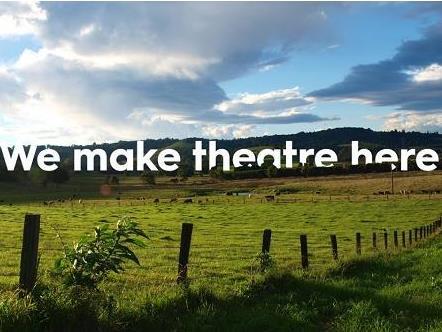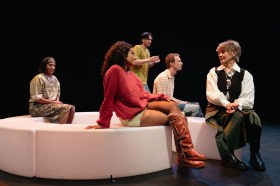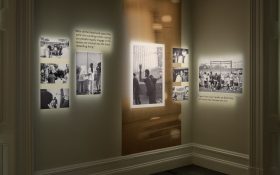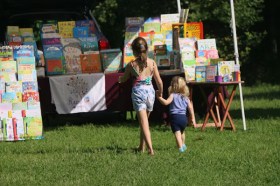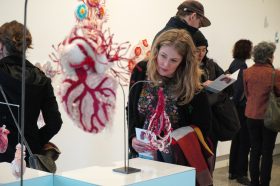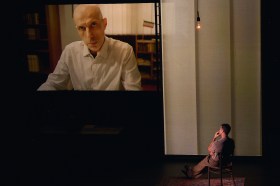If I were based in the city, I would not be creating the work I am making now. I would probably be searching for next year’s project by second-guessing that a particular play has something to say about the zeitgeist of the following year. The work I am able to build as a regional theatre maker comes from a specific place and emerges from a diverse community that reflects the complexity of contemporary Australia. Using improvisation, and working closely with a creative team and performers to explore thematic, or narrative, starting points creates pieces that inherently talk of today.
Our theatrical vision is built from collective experience, shared artistic instincts and the influences of the day. By bringing together performers from diverse art forms we develop work that is intrinsically Australian. Our works take approximately two years to make, and longer in some cases — particularly those projects that require collaboration with community. These works often do not start with a script, but the writer is in the room, shaping or following the action and integral to the free exchange of ideas being developed through play and experimentation.
NORPA’s experience is that artists require this amount of time to create good theatre, much more time than most theatre companies or producers allow. ‘Regional’ does not denote a vast void that is waiting to be filled. It is a bountiful and complex source of inspiration, and we look for stories that are beautiful and tough, surprising and dark, mysterious and dangerous.
Here is a selection of fascinating stories that we have unearthed in the last three years:
- American soldiers were sent to farms in the hills of the Northern Rivers for R&R during the Vietnam War
- The impact of Italian migration
- Finding love in the 21st century when you have a disability is challenging when one’s life is heavily structured
- The clash of cultures between the farmers and the hippies, and the subsequent changing nature of rural living
- Young people leaving the region
- Young men coming out
- The stories of the Bundjalung people who tried to claim their independence at Cubawee, which means “a place of full and plenty”
- That Djurra is lore and Mamoon is the second son that you can see lying down in the hills of Lismore.
It is time to fundamentally change our theatre’s perception of ‘regional Australia’ and to understand more about its potential role in shaping our identity, our art and ultimately our culture. Visual artists get it. Many past and present leading Australian visual artists are based in regional areas, or at least go there regularly for inspiration.
At the Prague Festival of Space and Design in 2015, thousands of European tourists and locals experienced NORPA’s Home Project. They did not say, ‘Oh, this is just about Lismore in regional Australia.’ Their response was, ‘So, this is Australia.’ Furthermore, when one looks internationally at other cultures’ theatre practice, the regions are not just treated as a place to tour existing works. Rather, regional companies overseas (that are a source of inspiration in my practice) are producing some of the most interesting work in the world in terms of originality, approach and rigour.
Read: Regional voices ignored by regional arts inquiry
Talking at the Directors Lab while attending the Melbourne Festival, Robert Lepage observed that making and presenting theatre outside a major city context has many unique opportunities for the artist. Robert Lepage outlined the benefits of living and working in Quebec City, which he considers small and the social fabric has more in common with regional values. He finds generally it be a less competitive environment than, for example, Montreal. That in a regional setting new work is less exposed and audiences feel safe enough to offer feedback on its first public outings. There is a kind of privacy in the process, enabling further development until it is ready to share with big-city audiences.
In Australia there is no ensemble equivalent to overseas companies such as Steppenwolf, Elevator Repair Service, Gecko Theatre, or Kneehigh, which enjoy longer gestation periods and graduated exposure of new work. By comparison our new works are often thrown to the mercy of reviewers too early – rushed towards an opening night, and not worked on again. Why is there no Australian equivalent to Theatre De Complicite where director/performer Simon McBurney and his creative team are still working on The Encounter after three seasons, taking the opportunity of bumping into a new theatre to explore the show’s ending?
Regional theatre in the UK is a source of many West End successes. Live Theatre is based in Newcastle. Its whole ethos is to create an environment that is conducive to making great work by supporting playwrights and testing the work in the regions before it travels. Kneehigh Theatre now travels the world but all their works are built in the same barn, in the same community, in regional Cornwall. Their style is stamped by the desire to both surprise and entertain their local audience with theatre that is accessible, highly theatrical, comic and physical, and scored with live music and song. Interestingly, both these companies started out doing much of their work in site specific or temporary theatre spaces. They took the work to the audience, using stories familiar to the community, and creating an appropriate style and atmosphere for storytelling.
Unless you have run a regional theatre company you may not see the demand for this – or the power of these experiences. Why do we ignore the creative potential of companies based regionally in Australia? Last year NORPA sold-out a three-week season of Railway Wonderland and yet, even offering to pay their airfares, we could not get a reviewer to come from any major newspaper. Apparently this is also a common experience for companies producing works in Western Sydney. Perhaps the funding bodies or support organisations could consider a scheme of setting in place a broader arts review system? Surely there are freelance writers who are prepared to travel to see new work created outside the metropolitan area.

Railway Wonderland by NORPA
Is it a fear of the bush? Are we still confronted by our historical narrative? Are we challenged by new dimensions within our culture? Is there a national fear of the possibilities of the unknown and what our country can be? Or is regional just a place for respite, fresh food and a nature fix?
What if every child who is made to read Shakespeare also learns an Indigenous creation story, and is asked to interpret it as a narrative, or song, or dance? What if the people where I live all learned a Bundjalung creation story? And you learned an equivalent story from where ever you live. Would we be a richer nation, and would regional areas hold more importance? Would we build more authenticity and pride in where we live and greater respect for First Nations people and for our Elders? Would our theatre embrace and tell more of our stories?
The integrity of NORPA’s work is judged on its relevance to the community as well as achieving excellence. For example, the Idiot Project, also known as Dreamer, which was a physical comedy project using some of the best comic performers drawn from three states. Rather than considering our exploration of themes in our local context, feedback from Ozco panel was, “What does Dostoyevsky have to do with Lismore?” Does this not beg the question, “What do Checkhov or Ibsen have to do with Sydney, or Melbourne?”
Art and culture do not just exist in regional areas to service social needs. Why is regional theatre viewed through a prism of need? Should regional theatre be forced to mostly have cultural community development criteria attached? Such projects are valuable, serve an important purpose and should be part of the ongoing mix, but it should not be the only lens through which regional theatre is assessed. Creating more quality theatre that celebrates and animates regional culture will make our national theatre more exciting, rougher, more potent and ultimately more Australian.
Read: The new cultural cringe
Regional Australia is not one generic place. In the same way that Melbourne is not like Sydney, Lismore is not like Dubbo. And Dubbo is not like The Pilbarra or Tamworth, or Darwin. The Northern Rivers is 20, 733 square kilometres and people travel from all parts of this area to see our shows. They will come to see a Bell Shakespeare or CIRCA production, but they crave our own locally made works which always out sell any other shows in the season. In the Northern Rivers, the creative industries are growing at twice the rate that they are in Sydney.
The migration narrative is no longer of tree changers but rather start-ups, entrepreneurs, young families and developers who are thinking outside the mainstream – beyond the limits of a city life. Djurra – connection to nature – is a fundamental need for human kind. The notion of ‘on country’ refers to the concept that the country is carrying you. It has more or less significance for each person but it is a phrase that I connect with deeply, and is one that I would like my children to learn from and be a part of. The role of our Indigenous stories and the First Nations communities, artists and culture-holders is vital. These are the works and stories we crave but if we make the work with these communities it will be stronger and authentic and the community will have ownership of it. It comes from there, from them.
In the late 1990s, the Nugent Report on which our current arts policies are based, established a system to preserve and protect Australia’s major arts companies. That was done to protect our cultural assets and to ensure a vibrant theatre sector. Later, the Federal Government created the Reserve Incentive Scheme to further bolster the financial stability of those major companies. Those policies have worked and those institutions are still in existence today.
Twenty years on it is time to ask ourselves how Australia has grown and changed, and whether this structure is still the best way to support the making of new Australia theatre. This is even more important when we consider Australia’s changing demographics, the effects of technology and the changes in regional Australia more generally. In the future do we want our theatre that tours the world to reflect a ‘whole Australia’ in the manner it explores form and story? Or do we want to keep presenting the current mix of borrowed art-forms and re-written classics?
Perhaps, with a dramatic shift in thought, and in a re-allocation of resources, we can develop the next cannon of classic Australian works. NORPA is “a major” in the regions. The sector has not kept up with the changing nature of contemporary Australia.
This article is based on a speech given at ARTLANDS Dubbo 2016.
